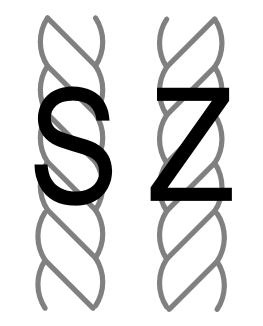ISO 2 on:
[Wikipedia]
[Google]
[Amazon]
 ISO 2 is an
ISO 2 is an
ISO 2:1973
Textiles — Designation of the direction of twist in yarns and related products Yarn #00002 {{Standard-stub
 ISO 2 is an
ISO 2 is an international standard
international standard is a technical standard developed by one or more international standards organizations. International standards are available for consideration and use worldwide. The most prominent such organization is the International Or ...
for direction of twist designation for yarn
Yarn is a long continuous length of interlocked fibres, used in sewing, crocheting, knitting, weaving, embroidery, ropemaking, and the production of textiles. Thread is a type of yarn intended for sewing by hand or machine. Modern manufact ...
s, complex yarns, slivers, slubbings, roving
A roving is a long and narrow bundle of fiber. Rovings are produced during the process of making spun yarn from wool fleece, raw cotton, or other fibres. Their main use is as fibre prepared for spinning, but they may also be used for specialised ...
s, cordage
Cordage may refer to:
* Rigging, cords and ropes attached to masts and sails on a ship or boat
* Rope, yarns, plies or strands twisted or braided together into a larger form
See also
* String (disambiguation)
* Cord (disambiguation)
Cord or ...
, and related products.
The standard uses capital letters
Letter case is the distinction between the letters that are in larger uppercase or capitals (or more formally ''majuscule'') and smaller lowercase (or more formally ''minuscule'') in the written representation of certain languages. The writing ...
S and Z to indicate the direction of twist, as suggested by the direction of slant of the central portions of these two letters. The handedness
In human biology, handedness is an individual's preferential use of one hand, known as the dominant hand, due to it being stronger, faster or more Fine motor skill, dextrous. The other hand, comparatively often the weaker, less dextrous or sim ...
of the twist is the direction of the twists as they progress away from an observer. Thus Z-twist is said to be right-handed
In human biology, handedness is an individual's preferential use of one hand, known as the dominant hand, due to it being stronger, faster or more dextrous. The other hand, comparatively often the weaker, less dextrous or simply less subjecti ...
, and S-twist to be left-handed. The convention of using these two letters to unambiguously designate twist direction was already used in the cordage industry by 1957.
References
External links
ISO 2:1973
Textiles — Designation of the direction of twist in yarns and related products Yarn #00002 {{Standard-stub